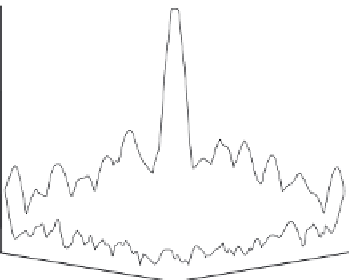Biomedical Engineering Reference
In-Depth Information
1
1
0.5
0.5
0
5
0
5
5
5
0
0
0
0
-5 -5
-5 -5
y (mm)
x (mm)
y (mm)
x (mm)
FIGURE 14.6
Simulation of lateral pressure profile for a 30 cm diameter hemispherical transducer ring element (external diameter 10 mm; inter-
nal diameter 7 mm) operating at 840 kHz with (left) 32 symmetrically arranged elements, (right) 32 randomly located elements.
Transducer design can improve treatment safety by minimiz-
ing heating and standing waves. Ultrasound pulse parameters
are also very important in achieving desired results without
unwanted effects. Thermal dose can be calculated from MR
thermometry images, allowing sonication time and the cool-
ing time between sonications to be selected. This allows control
of bone heating and avoids under- or overtreating the target
volume. In cavitation enhanced treatments, where microsec-
ond length pulses are repeated at low duty cycle, the contrast
agent dynamics must be considered. If the pulse repetition fre-
quency (PRF) is too high, the bubble population in the vessels
may not completely replenish between sonications [Goertz et al.,
2010], which could reduce treatment efficacy [McDannold et al.,
2008a]. If the PRF is too low, treatment efficiency may also be
reduced [O'Reilly et al., 2011].
Considering safety, several methods have been proposed to
minimize standing wave formation through pulse design. Sweep
frequencies [Mitri et al., 2005] have been used to eliminate
standing waves in vibroacoustography, while Tang and Clement
used randomized phase shifts [Tang and Clement 2009] to dis-
rupt the symmetry of the ultrasound and reduce standing wave
effects. In a simulation study, Deffieux and Konofagou [2010]
suppressed standing waves in human and primate skull models
using periodic fast linear chirps. For preclinical BBB disruption
(BBBD) research in small animal models, a modified pulse has
been proposed that eliminates standing waves in the skull cav-
ity [O'Reilly et al., 2010]. When large aperture transducers are
used, standing waves are geometrically minimized since a sharp
focus forms at the target, and at the skull base the acoustic field is
widely distributed. Combining a large aperture transducer with
a standing wave-suppressing pulse could improve procedure
safety even further for close to the skull base sonications.
and tissue vaporization generated during focused ultrasound
surgery, to low intensity effects such as blood-brain barrier
(BBB) disruption.
14.3.1 Hyperthermia
Heat has long been known to have detrimental effects on tissues
[Burger and Fuhrman, 1964a; Burger and Fuhrman, 1964b],
and great potential exists for the use of moderate temperature
increases for brain therapy. In hyperthermia, modest tempera-
tures (42- 48°C) are achieved and maintained over a period of
minutes to hours. Total-body hyperthermia has been used to
treat cancer with some response [Larkin, 1979]. However, given
the noted detrimental effects of heat on mammalian brain
[Harris, 1962; Burger and Fuhrman, 1964b, Lyons et al., 1986],
a more localized delivery technique is desirable. Microwave
hyperthermia combined with radiation therapy has been used to
treat superficial brain tumors in the past [Engin, 1993]. However,
the microwave energy is highly attenuated in tissues, limiting
treatment to superficial tumors or use of interstitial applica-
tors [Salcman and Samaras, 1983]. Ultrasound is able to bet-
ter penetrate soft tissues than microwaves, allowing it to reach
deeper seated tumors.
Lynn et al. first proposed the use of FUS in 1942, prior to which
biological work involving ultrasound was limited to the use of
plane waves. The use of FUS provides two main advantages over
unfocused ultrasound. First, by focusing the ultrasound energy,
higher intensities can be achieved at the transducer focus.
Second, ultrasound can be delivered to targeted areas without
affecting the surrounding tissue. These two factors make it an
ideal modality for conducting targeted hyperthermia. Energy
from the ultrasound beam passing through the tissue is depos-
ited as heat. When short sonications at low PRFs are used, perfu-
sion effects dominate and the local temperature rise is negligible.
However, for continuous wave sonications or those using high
PRFs, tissue heating can occur. The size and shape of the heated
region can be controlled by scanning the transducer focus across
the desired treatment volume (Figure 14.7).
14.3 therapeutic Effects of
Ultrasound on the Brain
The therapeutic effects of ultrasound on the brain are varied,
ranging from high intensity effects such as the thermal ablation





